#Antenna measurement equipment
Text
Demystifying Antenna Measurement Systems: A Comprehensive Guide
There's no denying that the world has shrunk. How? Well, everything is connected. From the smartphone ecosystems to satellites, aerospace dynamics, and whatnot, we thrive in an era of technological advancements. Many simple yet ubiquitous inventions have propelled our tech-enabled growth, and one of them is antennas. These simple machines are useful beyond our imagination, but to ensure antennas work efficiently within their expected range, antenna measurement systemsare used by manufacturers.
Antennas play a pivotal role in modern communication systems, enabling wireless connectivity across various industries. However, designing and optimizing antennas require precise measurement techniques. Antenna test systems provide invaluable insights into antenna performance, radiation patterns, efficiency, and other essential parameters. By accurately assessing these characteristics, engineers can refine designs, troubleshoot issues, and meet stringent performance standards.
Components of Antenna Measurement Equipment
Antenna measurement equipment consists of several key components, each serving a specific purpose. These include:
Positioner: The positioner allows controlled movement of the antenna during testing, enabling measurements at different angles and orientations. It ensures accurate data collection by precisely controlling the antenna's position.
RF Source: The RF source generates the radio frequency signal that powers the antenna during measurements. It provides a stable and adjustable signal to simulate real-world conditions.
Antenna Measurement Receiver: The receiver captures and analyzes the signals received from the antenna. It measures various parameters such as gain, radiation patterns, impedance, and polarization.
Measurement Software: This software facilitates data acquisition, processing, and analysis. It provides a user-friendly interface for controlling the measurement process, visualizing results, and generating reports.
Techniques in Antenna Measurement Systems
According to Business Research Insights, the market for Antenna measurement systems is projected to reach USD 1081.3 Bn by 2028.
Source: https://www.businessresearchinsights.com/market-reports/antenna-measurement-system-market-103008

These systems employ various techniques depending on the requirements and available resources. Here are a few commonly used techniques:
Near-Field Measurement: In this technique, the antenna is measured close to the source, allowing a detailed analysis of its characteristics. Near-field measurements are particularly useful for evaluating radiation patterns and detecting performance anomalies.
Far-Field Measurement: Far-field measurements are conducted at a distance from the antenna, simulating real-world operating conditions. These measurements provide insights into the antenna's radiation characteristics and allow evaluation of its performance at different angles.
Compact Range Measurement: Compact range measurement systems or antenna test chamberscreate an environment that mimics far-field conditions in a limited space. They enable accurate measurement of antenna performance without requiring an expansive outdoor test range.
Applications of Antenna Measurement Systems
Antenna measurement systems find applications in various industries, including telecommunications, aerospace, automotive, and research institutions. Here are a few notable applications:
5G Networks: Antenna measurement systems play a crucial role in the development and deployment of 5G networks, ensuring optimal performance, coverage, and compatibility with evolving standards.
Wireless Communication: These systems enable the characterization and testing of antennas used in wireless communication devices, such as smartphones, routers, and IoT devices, ensuring reliable connectivity.
Satellite Communication: Antenna measurement systems are employed to assess the performance of satellite antennas, ensuring accurate data transmission and reception.
Need more information on Antenna Measurement systems and wondering how they can be used? Contact the team at Simultech Australia now!
0 notes
Text
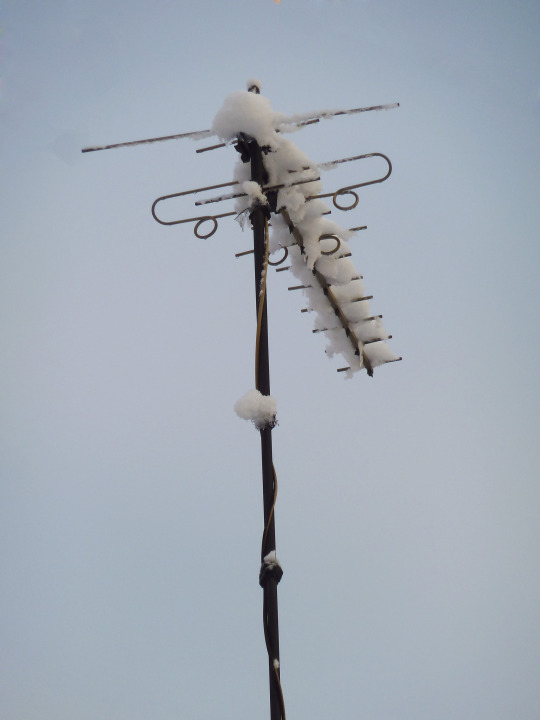
If you are looking for a reliable and efficient way to upgrade your communications system, then a DME Antenna is the perfect solution. DME antennas are state-of-the-art antenna systems that provide high-quality, long-range communication with a robust signal. Antenna Experts brings an extensive range of highly reliable and durable High Gain DME Antenna. Buy best Distance Measuring Equipment antenna at an affordable price.
#High Gain DME Antenna Supplier#DME Antenna#Distance Measuring Equipment (DME) Antenna#High Gain DME Antenna#DME Ground Station Antenna#High Gain DME Antenna Manufacturer
0 notes
Text
I've been thinking about teletherics and mica, especially since the appendices for 3.02 is a pocket guide to telethric transduction.
Teletherics is an Un-based technology, and teletheric waves aren't Fold-safe; the appendices for 1.05 mention that they need to be converted for rebroadcast into the Fold along cables for that reason. So, you can't transmit teletheric waves through the Fold. This is also suggested by the fact that Kozma's agenda lists all her teletheric calls after she leaves Midst; she can't have done it before then, in the Fold.
Apparently, teletherics can involve mica. The art of Backpack and her teletheric equipment includes a parabolic dish that uses a shard of mica as a feed antenna. Seeing as teletheric receivers, such as Ginsberg's in the icon for 1.03 and Hieronymous's in art for 3.02, don't feature visible mica, I presume then that her equipment is using it for transmission. If teletheric waves are transmitted using mica, that may explain why they're not Fold-safe. Teletheric signals are, of course, created using specially-boculated electric currents. A mica antenna would interact with that, then radiate it to a receiving teletheric transducer.
As a sidebar, the breakdown of the word teletheric is also very interesting to me: tele- + aetheric. I wonder if the Un is as empty as it seems to be when in compared to the Fold. Perhaps there is some stuff out there in the Un that they have not yet learned to measure. Or, perhaps teletheric is aetheric in the sense of aether theory and the transmission of waves through a medium. Or, in the sense of luminiferous aether and old theories on the movement of light. Or, perhaps in the sense of the mythological personification of the bright upper sky.
If mica is capable of transmitting teletheric waves, how do teletheric signals interact with the mica fields of the Un? Radio engineering is not as simply as any old piece of metal can act as an antenna, there's electric currents and what-not, but in this fantasy world in which our understanding of teletherics and mica is limited, it is a question. (And who is to say that things don't work slightly differently in the cosmos.) Do teletheric signals interact with mica bergs at all? Does wild mica bounce those signals across the Un?
If mica transmits signals, waves, does it have resonance then? Does it vibrate? Do mica bergs make sound as they float through the Un, and is it audible? Or, does it resonate a tone that is below the typical threshold of human hearing, like the third sound of a superfluid?
Hell, while I'm asking questions. Can someone end up with the opposite of what Lark has with the Fold, where they can hear mica resonating through the Un? Is there some soul out there, cosmos whispering to them, who can hear its crystalline tones resonating out across the Un, or the sound of lightning in the Delta or unships passing through the upper Un bouncing off the bergs, or teletheric signals transmitting out through the mica?
But, I'm getting ahead of myself: mica and teletherics and the transmission of sound. I think about teletherics and the shapes of all associated with it. Priathic notation reminds me of neumes, or even modern notation with beams but no stems. The impulses are tonal and have harmonics. Teletheric transducers uses fluted pipes, and those pipes make them look like small pipe organs. With that—
Does mica sing? Can you hear it if you tune in just right?
#I just LOVE asking questions about the way a fictional world works knowing I will never get answers. It's just FUN for me to think about.#What is the material reality of the cosmos!! It's fun to spin questions out of it!#Midst#Midst podcast#Midst things
40 notes
·
View notes
Text

Cold-Operations Dope, wrapped in a thick insulated jacket to stem heat loss, as well as providing a small degree of extra protection from enemy fire. This does necessitate the movement of the antennae to the head unit, with communication equipment housed in its own insulated covering.
Aside from the jacket, the frame is fairly similar to factory stock, with just snow-shoes and smaller leg vents marking it as different. Armament is a practical 40mm mech-scale assault rifle, supplemented by the standard chest mounted IR laser and a shoulder mounted box holding a pair of optical, wire guided missiles, with four smoke grenades on top of that.
Part of the simplicity of the alteration is just a cost-cutting measure - Cold-Op mechs usually aren't produced in great numbers, so using off the shelf components helps limit cost increases that often come with specialised units like this.
117 notes
·
View notes
Text
So, and correct me if I'm wrong, this is the only completely secure way to communicate over the internet:
1. Get a second computer which you will from now on never connect to the internet nor in any way allow to talk with any other computer, including flash drives, cables, Bluetooth, whatever.
2. Get it inside a Faraday cage that has an airlock type door so that you can always keep it closed.
This is because even of you rip out the antennas on a device, all modern motherboards have a backdoor which allows any government agents with proper equipment to compromise it via short range radio.
For good measure, get that computer its own power supply separate from the grid, to truly air gap it from the internet.
3. Anything which ever appears on any computer or phone can immediately be considered known to every security agency in the world, since all modern devices have backdoors put there for that reason.
Therefore, install on the other computer an encryption program(best if you make it yourself), whose resulting meaningless jumble of digits you by hand copy over to send to whoever needs it, presuming you gave them the key to decrypt it irl scribbled on a note or via the usual public private key method.
If any of this could be made simpler, please tell me, but I'm pretty sure that it can't.
50 notes
·
View notes
Text

Study Offers Improved Look at Earth’s Ionosphere
New measuring techniques will enable improved measurements of the Earth’s ionosphere, a key to studying and reducing the impact of space weather.
Radio signals have been used to study the density of plasma since the 1920s. Transmitting radio sources include ground-based ionosondes (special radar for the examination of the ionosphere), astronomical phenomena such as pulsars and more recently spacecraft signals used for transmitting data. For example, Global Positioning Satellites (GPS) radio signals are used to measure the density of Earth’s ionosphere. However, the response of the radio signal to the ionospheric plasma is more complicated than simply varying as a function of density. The Earth’s magnetic field affects its electromagnetic wave fluctuations as well. For example, Faraday rotation is a well-known phenomenon, as shown in the image above. But, as a technique for measuring magnetic field, Faraday rotation is limited to just the portion that is oriented in the correct direction. Our discovery complements Faraday rotation enabling a complete measurement of magnetic field strength.
“We discovered that the magnetic field was introducing noise to radio signals. The immediate impact of this work is to enable improved measurements of the Earth’s ionosphere. Additionally, all of the adverse conditions discussed about the hazards of space weather ultimately are driven by the Earth’s ionosphere responding to the Sun’s plasma,” said Elizabeth Jensen, Planetary Science Institute Associate Researcher Scientist and lead author of “The Hunt for Perpendicular Magnetic Field Measurements in Plasma” that appears in The Astrophysical Journal. “By reducing the error in GPS signals from the horizon and expanding the coverage to the poles, issues with communication fidelity losses are immediately improved.”
The effect of the plasma’s perpendicular magnetic field on radio propagation is shown in the image below. “We have discovered how to improve communications between the Earth and spacecraft; how to measure the strength of the magnetic field in space plasmas, an important result for improving space weather predictions; and how to obtain magnetic field measurements from some older archived spacecraft data,” Jensen said. “This is with our breakthrough discovery on how to isolate the contribution of the magnetic field perpendicular to the signal path in radio data.”
Space weather prediction, the physics behind destabilizing the ionosphere by the Sun’s plasma, is dominated by the temperature, velocity, density, and magnetic field of the plasma arriving from the Sun. The greatest source of error in these space weather models derives from the lack of magnetic field measurements in the intervening space between the Sun and the Earth. Improving our ability to predict space weather, via improved magnetic field measurements, enables reducing the costs from these adverse conditions.
“Here on Earth, we are primarily concerned with space weather. Space weather consists of the response of the Earth’s plasma regions to the plasma released by the Sun. Adverse conditions from this interaction include satellite damage, irradiating personnel not just in the space station but on flights near the poles, poor communications from a loss of signal fidelity impacting aircraft and other GPS-dependent equipment, for example self-driving vehicles, and damage to equipment such as power lines or subsea cables,” Jensen said.
This work was supported by Planetary Science Institute and University of Utah facilities. Collaborators Jamesina Simpson and Yaser Rahmani put in their personal time for this effort. Jensen was self-funded through her company, ACS Engineering & Safety.
IMAGE....Radio signal plasma wave from a parallel magnetic field. This animation shows the Faraday rotation phenomena in black. The grid at the end of the propagation path is the antenna, and the black line shows how the plane of polarization of the radio signal projects onto it.
Credit: E. Jensen/PSI.
18 notes
·
View notes
Text
Trial Eight Test Report
Subject: L0294
Pre-treatment Notes: L0294 is a female Ymir's group wasp weighing approximately 95 kg and measured at 2.4 meters. Most of its head has been overtaken by growths from a species of fungus believed to have convergent evolved alongside Earth's Ophiocordyceps unilateralis. Both of its antennae had taken significant damage and its thorax and abdomen are severely bloated. Roughly half of the hair that would normally cover its body is missing, and its wings are torn in multiple places. L0294's behavior is described as lethargic, showing little interest in its surroundings.
Treatment Administered: Prototype A9
Results: Subject L0294's fungal growths turned black upon being administered its first dose of Prototype A9, and within hours, L0294 ceased its attempts to climb the walls of its enclosure. Over subsequent doses of Prototype A9, L0294's body became increasingly discolored, eventually turning a dark shade of gray. Additional tissue began to grow on top of L0294's fungal growths. L0294 has become more aggressive, but has not regained its instinctual burrowing behaviors.
Current Status: Alive
Recommendations: Upgrade the air filtration system in L0294's containment. Its fungal growths have begun to secrete a dark purple mist which contain its spores. Any personnel entering its containment chamber are advised to equip full biohazard gear. Additional tests with sedatives may be administered to make L0294 more compliant with further experimentation.
Submitted to: Agent Mobius M. Mobius
#loki au#loki series#tva loki#body horro tw#body horrow cw#mcu!loki#dark au#unethical experiments tw#dehumanization tw#i guess#i mean she's not a human but Ymir's Ground Wasps are sentient#not tva friendly
3 notes
·
View notes
Text
Are EMF’s safe? (come, child, ruin your night)
y’all ready for this?
I’m not anti-5G, btw
turn your wifi off before bed and maybe stop keepin’ ya phone so close all the time
But like... why, though?
I've had my suspicions about cell towers being hazardous to health for a few years now and felt convinced enough to not bother researchin' it for confirmation. Now that I'm blah blah blah, I decided to actually bother. Since it got kinda heavy, I had to ask myself if I should put in hella more effort creatin' a damn research report of sorts for y'all asses present the info for others like it's a damn PSA. And my conscious won. T~T
But like... what, though?
A base station (aka: cell phone tower) is that shit you see everywhere but never notice. It's usually tall af and has panel antennas on it. It's "used for the transmission and reception of the radio signals between the mobile phones and the network." The problem with 'em is the electromagnetic field (EMF) their equipment can give off... for half a mile. 😐
In short, they've been found to cause health problems. Like cancer. 🤷🏿♂️
Fun fact, panel antennas can be installed on the roof/side of buildings that may be directly across the street from someone's workplace... with the antenna at their elevation. 🤷🏿♀️
Real Quick
For those who don’t trust EMF-Portal, it (sometimes) has links to the study/article.
Full-text PDF can be requested directly from the authors on ResearchGate.net’s article for the study.
Full-text PDF can (usually) be found online in English and German with the right search.
5 Studies
V/m = volts per meter
7191 cancer deaths were selected according to the above mentioned criterias out of a total of 22,493 cancer deaths. The most significant causes were lung cancer (19.6 %), stomach cancer (14.1 %), prostate cancer (12.6 %), and breast cancer (11.5 %). The mean electric field intensity of the measurements in 2008 was 7.32 V/m, varying from 0.4 to 12.4 V/m.
At a distance of up to 100 m [328.08 ft], the absolute number of deaths was 3569, (49.6 % of all deaths), the mortality rate was 43.4 persons per 10,000 [0.43%] and the relative risk was 1.35 in relation to the mortality rate of 32.1 per 10,000 [0.32%] inhabitants of the entire Belo Horizonte municipality [in Minas Gerais, Brazil]. A mortality rate of 34.8 per 10,000 [0.35%] inhabitants was observed for the residents living within 500 m [1,640.42 ft] of the base stations; this rate decreased for residents living farther from the base stations.
—Mortality by neoplasia and cellular telephone base stations in the Belo Horizonte municipality, Minas Gerais state, Brazil; Science of The Total Environment (2011); EMF-Portal
ResearchGate.net’s article


The result of the study [of 967 permanent residents] shows that the proportion of newly developing cancer cases was significantly higher among those [320] patients who had lived during the past ten years at a distance of up to 400 metres [1,312.34 ft] from the cellular transmitter site, which has been in operation since 1993, compared to those patients living further away, and that the patients fell ill on average 8 years earlier. In the years 1999-2004, ie after five years' operation of the transmitting installation, the relative risk of getting cancer had trebled for the residents of the area in the proximity of the installation compared to the inhabitants of Naila[,Germany,] outside the area.
—The Influence of Being Physically Near to a Cell Phone Transmission Mast on the Incidence of Cancer (original title: ‘Einfluss der räumlichen Nähe von Mobilfunksendeanlagen auf die Krebsinzidenz’); Umwelt · Medizin · Gesellschaft (2004); ResearchGate.net
EMF-Portal

9 cancer cases were observed in the first period 2000 - 2004 and 14 cases in the period 2005 - June 2007 among [1,283] residents living within a radius of 400 m [1,312.34 ft] to a mobile phone base station [in Germany (Hennen, suburb of Iserlohn, Westfalia)]. The mean age of disease onset was 59.2 years in the first period and 59.3 years in the second period in comparison to the expected value of 66.4 years evaluated from the Saarland Cancer Registry. The authors concluded, that a statistically significant increase of cancer incidence was observed 5 years after the base station has been started operating.
—[Incidence of cancer adjacent to a mobile telephone basis station in Westfalia] (original title: Krebsinzidenz von Anwohnern im Umkreis einer Mobilfunksendeanlage in Westfalen - Interview-basierte Piloterhebung und Risikoschätzung); Umwelt · Medizin · Gesellschaft (2009); EMF-Portal
Area A: ≤ 350 m / 1148.3 ft from base station
Area B: > 350 m / 1148.3 ft from base station
Of the 622 people of area A, 8 cases of different kinds of cancer were diagnosed in a period of one year (from July 1997 - June 1998). The cancer incidence rate was 129 cases per 10,000 [1.29%] persons per year in area A compared to 16/10,000 [0.16%] in area B and 31/10,000 [0.31%] in the town of Netanya [in Israel]. Relative cancer rates for females were 10.5 for area A, 0.6 for area B and 1 for Netanya.
The authors conclude that the study indicates an association between increased incidence of cancer and living in proximity to a mobile phone base station.
—Increased incidence of cancer near a cell-phone transmitter station; International Journal of Cancer Prevention (2004); EMF-Portal
ResearchGate.net

Took forever to get this damn infographic just right. >.>
A long-term study was conducted in Germany to investigate the influence of a mobile phone base station on neurotransmitters under true-to-life conditions.
µW/m² = microWatts per square meter
24 out of 60 participants were exposed to a power density of < 60 µW/m², 20 participants to 60 - 100 µW/m², and 16 participants to more than 100 µW/m² .
The values of the stress hormones adrenaline and noradrenaline grew significantly during the first 6 months after starting the GSM base station; the values of the precursor substance dopamine substantially decreased in this time period. The initial condition was not restored even after 1.5 years. Due to the not regulable chronic difficulties of the stress balance, the phenylethylamine levels dropped until the end of the investigation period. The effects show a dose-effect relationship and are situated far under the valid limit values.
—[Modification of clinically important neurotransmitters under the influence of modulated high-frequency fields - A long-term study under true-to-life conditions] (original title: Veränderung klinisch bedeutsamer Neurotransmitter unter dem Einfluss modulierter hochfrequenter Felder - Eine Langzeiterhebung unter lebensnahen Bedingungen); Umwelt · Medizin · Gesellschaft (2011); EMF-Portal
ResearchGate.net’s German article
EMF:data page (German)
While I did find 17 different figures for it, I’mma save myself the bother of describin’ dat noise and not include ‘em thanks~.
But what does the FCC say?
FCC.gov’s conclusion seems to be that they’re generally safe for civilian life as long as you don’t get close and aren’t directly in front of the antenna’s trajectory (don’t climb a fuckin’ tower or enter those rooms/buildings). A very “it’s fine” set of conclusions tbh. Hella contrasted by other sources.
Nonetheless… below is the index...
FCC’s RF Safety FAQ Index:
What is "radiofrequency" and microwave radiation?
What is non-ionizing radiation?
How is radiofrequency energy used?
How is radiofrequency radiation measured?
What biological effects can be caused by RF energy?
Can people be exposed to levels of radiofrequency radiation and microwaves that could be harmful?
Can radiofrequency radiation cause cancer?
What research is being done on RF biological effects?
What levels are safe for exposure to RF energy?
Why has the FCC adopted guidelines for RF exposure?
How safe are mobile phones? Can they cause cancer?
How can I obtain the specific absorption rate (SAR) value for my mobile phone?
Do "hands-free" ear pieces for mobile phones reduce exposure to RF emissions? What about mobile phone accessories that claim to shield the head from RF radiation?
Can mobile phones be used safely in hospitals and near medical telemetry equipment?
Are wireless and PCS towers and antennas safe?
Are cellular and other radio towers located near homes or schools safe for residents and students?
Are emissions from radio and television antennas safe?
How safe are radio antennas used for paging and "two-way" communications? What about "push-to-talk" radios such as "walkie-talkies?"
How safe are microwave and satellite antennas?
Are RF emissions from amateur radio stations harmful?
What is the FCC's policy on radiofrequency warning signs? For example, when should signs be posted, where should they be located and what should they say?
Can implanted electronic cardiac pacemakers be affected by nearby RF devices such as microwave ovens or cellular telephones?
Does the FCC regulate exposure to radiation from microwave ovens, television sets and computer monitors?
Does the FCC routinely monitor radiofrequency radiation from antennas?
Does the FCC maintain a database that includes information on the location and technical parameters of all the towers and antennas it regulates?
Which other federal agencies have responsibilities related to potential RF health effects?
Can local and state governmental bodies establish limits for RF exposure?
Where can I obtain more information on potential health effects of radiofrequency energy?
The Government Accountability Office (GAO) prepared a [2012] report of its investigation into safety concerns related to mobile phones. The report concluded that further research is needed to confirm whether mobile phones are completely safe for the user, and the report recommended that the FDA take the lead in monitoring the latest research results.
Professional Opinion...
Safe Distance from Cell Towers…
It is also difficult to predict a safe distance from cell towers. For example, cell towers are designed to transmit most of their radio frequency (RF) energy horizontally. Some areas below the tower may have lower levels than locations farther away that are more in line with the vertical height of the antennas.
The exposure from a cell tower will depend on the type of antennas, the number of antennas, how much the antennas are actually being used, the time of day, etc. The distance needed to reduce exposures down to the General Public Precautionary Level of 100 microwatts per meter squared (μW/m²) is often around a quarter of a mile (1320 feet) or more. Due to the uncertainty, on-site testing with a broadband RF test meter is strongly recommended.
A German study reported that people living within 400 meters (1312 feet) of cell towers had over 3 times the normal rate for new cancers (City of Naila 2004). In an Israeli study, the relative risk for cancer was about 4 times greater within 350 meters (1148 feet) of the cell tower (Wolf et al. 1997). Based on findings like these, a minimum safety distance of 1/4 mile (1320 feet) might be considered prudent.
(...)
The suggestions for safety distances in this chart are generally based on Michael Neuert’s [engineer, licensed electrician, and health educator] professional on-site testing of the various EMF sources in the San Francisco Bay Area since 1992.
—What Distance is Safe? By Michael R Neuert, MA, BSME, ©2023
helpful table if you want all that info: What EMF Level is Safe? By Michael R Neuert, MA, BSME, ©2023
i know what i said
Based on the accumulated evidence, we recommend that IARC [the International Agency for Research on Cancer] re-evaluate its 2011 classification of the human carcinogenicity of RFR [radio-frequency radiation], and that WHO [the World Health Organization] complete a systematic review of multiple other health effects such as sperm damage. In the interim, current knowledge provides justification for governments, public health authorities, and physicians/allied health professionals to warn the population that having a cell phone next to the body is harmful, and to support measures to reduce all exposures to RFR.
—Risks to Health and Well-Being From Radio-Frequency Radiation Emitted by Cell Phones and Other Wireless Devices; Front Public Health (2019 Aug 13); NCBI
Lookup (or pull out) your cellphone’s manual and search for the sections on “radio frequency exposure” and “Specific Absorption Rate (SAR) information” to see how close the phone can safely be kept near your body… and that it should be kept away from “the bellies of pregnant women and for teenagers, away from the lower abdomen.” 😐
For an informative giggle, here’s the “Harmful Cell Phones” segment from season 7 of The Colbert Report.
#research#long post#scientific study#telecommunications#telephone base stations#mobile phone base stations#cell towers#cell sites#transmission masts#basis stations#panel antennas#EMF#wifi#cell phones#radiation#cancer#ResearchGate#FCC#RF Safety#radio-frequency radiation#IARC#World Health Organization#physical health#mental health#EMF-Portal#nothin' to see here people#just another day(s) of my life wasted#move along#pretty sure i saw a lone panel antenna relatively low af on a street light pole once
1 note
·
View note
Text
Here is why Your Jaguar’s Radio is not working

Now a days cars are not only equipped with better safety features, but also some accessories that make you feel refreshed while travelling in a car. One of such accessories is your car’s radio. A radio makes easy to pass time while travelling for a long time in a car. But imagine if you are going for picnic with your whole family and you have to travel a long distance, but unfortunately your radio is not working properly or not working at all. Then this long time travelling would become severely frustrating not only for you but for all of your family members. Kids would get easily bored and irritated. A malfunctioning radio can spoil your mood. If your radio is no working, then you can get it fixed, but before that you must know what can be the culprit in this case.
Role of radio in happy driving
Now a days everyone know what a radio is. It is one of the old means of infotainment. But still radios are in use. In cars, while travelling it sill provides you some necessary information and entertains you by music and entertaining programs. A radio provides the audiences to listen the radio shows and podcasts. A radio makes a long time taking journey to simpler and enjoyable driving. So a radio can be a complete travel companion, because every time you switch on your radio while driving, you always have a very good driving experience. A radio always make your travelling more enjoyable by entertaining the whole time you are driving your car. Nearly all jaguar car users’ use radio, so naturally, malfunctioning of radio can make them frustrated. So you must know what are the possible causes the malfunctioning of radio before diagnosing the issue.
What causes the radio to die?
A radio is an electronic accessory component in a car. It depends on electricity to run. So malfunctioning of radio can be an electrical issue. If it would not get electricity of proper voltage, then it would not run at all. Here are some reasons that commonly causes radios to stop working.
Fuse blown out
Fuse are protective components present in electrical devices that protects them from power surges. Whenever more electrical power passes through it, it melts and breaks leading to open circuit. So the power supply can be stopped and the electrical device is saved from high power. Fuse allows the current to pass, but if it is blown, then the current would not pass in its circuit and the device would stop working. Blown fuse is the most common culprit of a malfunctioning radio. If you encounter such problem then check its fuse first.
Damaged antenna
Radio receives signal by the help of antenna and processes it to get the audio. If your radio is no working, then problem can be in the antenna itself, because without antenna signals would not be received properly and radio would not work.
Faulty wiring
A faulty wiring is usually found in third party installations of stereos done in cars because mostly, those stereos are not designed to work in that car. So these are wrongly installed, which easily get loosened with time by vibrations of the car. Due to loose vibrations, the radio stops working properly.
Faulty speaker
A speaker makes the sound audible to every passengers in the car. Without speaker, the radio would of no use. If the speaker is damaged or its contacts with wires is loosened then the speaker would not produce sound properly. The radio displaying normally but no sound from speaker is a very good sign of faulty speaker.
Problems in the battery or its connections
If the battery is dying or got weak or its connections with the car is loosened, then a disruption on power flow occurs, due to this problem the radio have a feature called anti-theft measure which shuts off the radio and conserves the energy from the battery. Then you will find that the display in the radio is different than normal.
Conclusion
If the radio is malfunctioning, then first check the fuse inside it. A blown fuse is to be replaced. Then check the wirings, the speaker and the antenna. Every malfunctioning in radio is to be fixed by car professionals. You can contact your dealer to have them fixed.
2 notes
·
View notes
Text
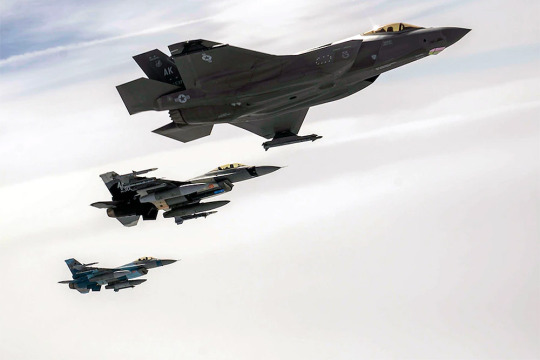
Cost and operational availability of the main aeronautical assets
Fernando Valduga By Fernando Valduga 10/09/2022 - 12:00 in Military
The correct evaluation of a combatant force, - whether surface ships (crusaders, destroyers and frigates), submarines, combat tanks (MBT) or aircraft - needs to take into account, in addition to the expenditures with the development of the project and acquisition of the means, its operational cost and availability.
By way of example, the current nuclear propulsion missile launchers (SSBN) submarines have an operational availability of approximately 50%. Not for any other reason, the U.S. Navy hopes, with the new "Columbia" class, to increase this percentage in relation to the "Ohio" class, allowing the current number of 14 vessels with 24 SLBM (Submarine-Launched Ballistic Missiles) missiles each to be replaced, without prejudice to efficiency, by 12 units equipped with 16 SLBM missiles

On the other hand, the operational availability of the 400 ICBM (Inter-Continental Ballistic Missiles) LGM-30 Minuteman III is close to 95%. In fact, this is exactly the synergy of the nuclear triad, since each vector, - SLBM launched from submarines, ICBM in reinforced silos and ALCM (Air-Launched Cruise Missiles) fired from strategic bombers -, has confrontational advantages and disadvantages, which make the "everything" more efficient than each of the types of vectors separately considered
In the particular case of combat aircraft, in addition to their operational capacity, it is always necessary to evaluate the operational cost and availability, including the measurement of life cycle values.
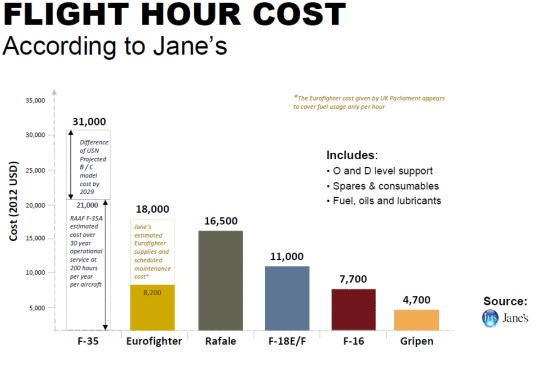
In 2012, the most reliable numbers then available indicated that, as for the first parameter, the Eurofighter Typhoon (US$ 18 thousand/hour of flight) spends little more than twice as much as a Lockheed F-16 Falcon (US$7.7 thousand/hour), more than three times in relation to the Saab Gripen C/D (US$ 4.7 thousand/hour) and
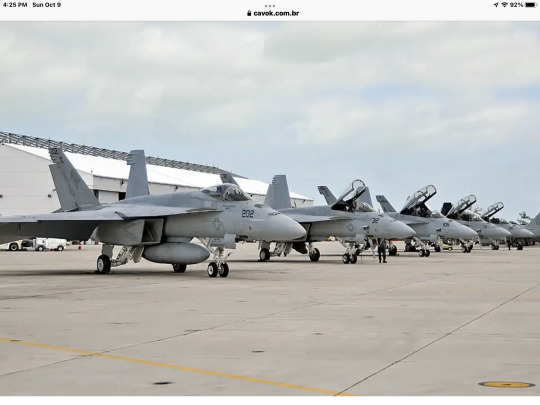
When it comes to 5th generation aircraft, with stealth capability, the values are even higher, forcing a Lockheed Martin F-35A Lightning II to consume about US$ 38,000/hour of flight. Already the hourly cost of flight of a Lockheed Martin F-22 Raptor, - the most capable and sophisticated fighter in service on the U. S. Air Force (USAF) -, can revolve around an impressive $70,000, about 10 times more than the operating costs of the Gripen I/F (these values are current).
The great impact of costs comes from several factors (considering the high complexity of the Raptor), but mainly from the sophisticated coatings of the aircraft, which expand its stealth capacity. These coatings are made of special materials that absorb the energy radiated by radars, and the "skin" of the fighter also has a complex internal structure in the form of a hive. The F-22 also incorporates a number of innovative systems that substantially increase maintenance costs, such as the complex Radar Warning Receiver, which includes more than 30 antennas scattered throughout the aircraft.
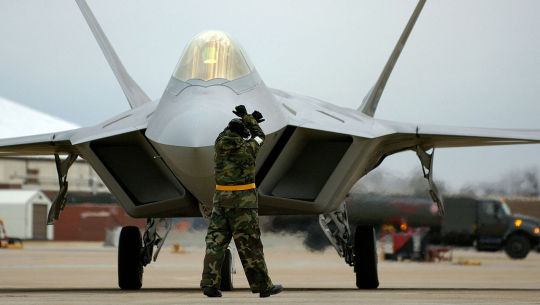
Thus, each F-22 requires more than 40 hours of maintenance for each hour of flight, greatly reducing its operational availability. To give you an idea, allegedly only 40-50% of the F-22 fleet (accounted in 2021 on a total of 165 aircraft in the USAF and another 20 in the Air National Guard - ANG, according to 'The Military Balance 2021", IISS, London, ps. 58-59), or approximately 90 aircraft, is completely able, at a given time, to carry out
Very differently from what common sense deduces, fuel expenses have very little impact on the composition of these values, not only in the case of the Raptor but also in the case of other equally complex aircraft (the F-35 Lightning II stealth light fighter and the Stealth Northrop Grumman B-2 Spirit bomber, for example). Fuel expenses vary according to numerous factors, but, on average, an F-22 consumes 2,000 to 3,000 gallons per hour, representing an average expenditure of about US$ 5,000/hour of flight, that is, less than 10% of the total value.
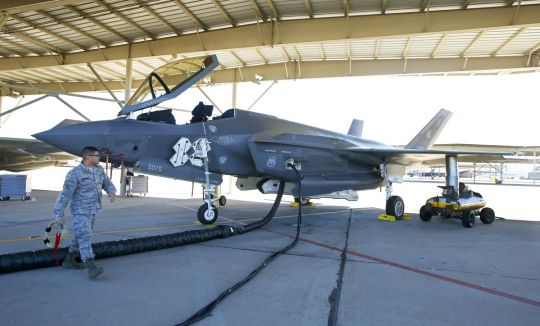
Another important factor that aircraft operators account for is the so-called "cost per life cycle", referring to the expenditures of an aircraft during the entire time lapse foreseen for its operation. In the case of Raptor, it is estimated at $334 million, meaning that each F-22 will demand this amount throughout its period of operational activity.
In terms of operational availability, as a rule, the more complex and capable the combat plane, the lower its percentage degree of availability. Thus, despite being the Grumman F-14D Super Tomcat (with its AIM-54 Phoenix missiles guided by active radar and with more than 200km of range) more capable than the F-18E/F Super Hornet (which replaced it), its operational availability (depending on the number of man-to-home hours required for maintenance) was lower. Thus, the replacement undertaken by U. S. Navy enabled a greater number of aircraft available for emergency use.
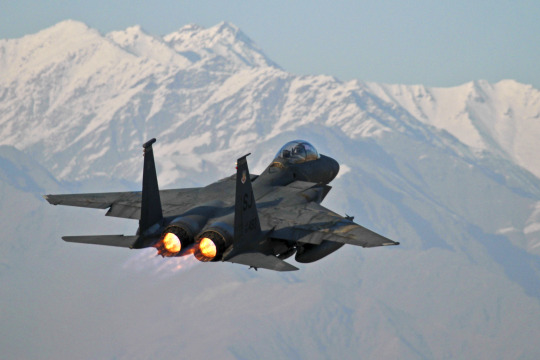
In the same sense, the superiority of the Boeing F-15 Eagle (never shot down in aerial combat) and its latest version, the F-15EX Eagle II, over the latest version of the F-16 Falcon remains indisputable. However, the costs of its flight hour are much higher and its operational availability (number of fleet aircraft ready for combat) is much lower, requiring the USAF to have a "mix" of aircraft of both models, conceiving an indispensable complementarity between combative capacity and operational availability.
Reis Friede - Professor Emeritus of the School of Command and Chief of the Army (ECEME), Honorary Professor of the School of Command and General Staff of Aeronautics (ECEMAR), Professor Emeritus of the School of Improvement of Army Officers (EsAO) and Special Lecturer of the School of War (ESG).
Tags: Military AviationUSAF - United States Air Force / US Air Force
Previous news
Thai Air Force awaits U.S. response for purchase of two F-35s
Next news
Indian Air Force wants to extend the life of its Su-30MKI for another 10 years
Fernando Valduga
Fernando Valduga
Aviation photographer and pilot since 1992, he has participated in several events and air operations, such as Cruzex, AirVenture, Dayton Airshow and FIDAE. It has works published in specialized aviation magazines in Brazil and abroad. Uses Canon equipment during his photographic work in the world of aviation.
Related news
MILITARY
U.S. Navy jet flew over the Baltic hours after the Nord Stream explosion
09/10/2022 - 16:37
MILITARY
Indian Air Force wants to extend the life of its Su-30MKI for another 10 years
09/10/2022 - 14:00
MILITARY
Thai Air Force awaits U.S. response for purchase of two F-35s
09/10/2022 - 10:52
TECHNOLOGY
Pentagon announces new contract to increase the time of hypersonic flight tests
09/10/2022 - 10:21
MILITARY
Swedish Gripens perform in-flight refuelling tests with NATO A330 MRTT
08/10/2022 - 21:03
BRAZIL
Brazilian Navy releases official note on return of NAe São Paulo hull to Brazil
08/10/2022 - 16:05
homeMain PageEditorialsINFORMATIONeventsCooperateSpecialitiesadvertiseabout
Cavok Brazil - Digital Tchê Web Creation
Commercial
Executive
Helicopters
HISTORY
Military
Brazilian Air Force
Space
Specialities
Cavok Brazil - Digital Tchê Web Creation
4 notes
·
View notes
Text
Certified Wireless Network Administrator CWNA-109 Dumps Questions
The Certified Wireless Network Administrator (CWNA) certification represents a foundational level credential in the realm of wireless LANs, and is a part of the comprehensive Certified Wireless Network Professional (CWNP) Program. The process of successfully passing the CWNA-109 examination, and consequently obtaining the Certified Wireless Network Administrator certification, significantly enhances your appeal in the job market within the wireless networking industry. This could potentially pave the way for substantial career advancement.
In order to assist you in this endeavor, Certspots offers its Certified Wireless Network Administrator CWNA-109 Dumps Questions. These are meticulously crafted, based on actual examination questions and answers, providing an effective way for you to gauge your knowledge and hone your skills. The Certified Wireless Network Administrator CWNA-109 Dumps Questions are routinely updated to reflect the most current examination content. Thus, they serve as an invaluable tool, equipping you with the knowledge and confidence required to pass your exam, ensuring your success is virtually guaranteed.
youtube
Certified Wireless Network Administrator: What You Need to Know
The CWNA certification, a foundational wireless LAN certification under the CWNP Program, requires you to pass the CWNA exam at a Pearson Vue Testing Center with a score of at least 70%. For instructors, the passing score is 80%. Your preparation for the CWNA exam should begin with understanding the exam objectives, which outline the skills evaluated in the exam. The CWNA certification remains valid for three years. To renew it, you need to pass one of the professional-level certification exams (CWSP, CWDP, CWAP) before your CWNA certification expires, which will extend its validity by another three years. Alternatively, you can retake the current CWNA exam. Though not mandatory, the Certified Wireless Specialist (CWS) and Certified Wireless Technician (CWT) certifications are strongly suggested as they offer a solid foundational understanding before advancing to the CWNA certification.
Main Areas Covered by CWNA-109 Exam:
The content of this training for the Certified Wireless Network Administrator (CWNA) is designed specifically for those at the entry-level. It thoroughly covers all the objectives listed in the CWNA-109 exam, which is the mandatory exam to obtain the Certified Wireless Network Administrator certification. This training will equip you with the necessary knowledge and skills in several crucial areas.
Firstly, we delve into Radio Frequency (RF) Technologies where we explore the basic principles and functionality that underpin wireless communications. Next, we demystify Antenna Concepts to understand how signals are transmitted and received in a wireless network.
Our third area of study focuses on Wireless LAN Hardware and Software. Here, we will look at the various components that make a wireless network function efficiently. We will examine routers, switches, access points, and the software that helps manage these devices.
Then, we turn our attention to Network Design, Installation, and Management. This part of the course will teach you how to design a wireless network to meet specific needs, how to install and set it up correctly, and how to manage it effectively.
Moving on, we will look at Wireless Standards and Organizations, where we will learn about the various standards that govern wireless networks and the organizations that develop and maintain these standards.
The 802.11 Network Architecture is another major topic we will cover. This includes understanding the different types of 802.11 networks and their applications.
Next, the course will cover Wireless LAN Security. This section will give you an overview of the potential threats to a wireless LAN and the measures that can be taken to mitigate these risks.
Lastly, we will teach you Troubleshooting techniques to identify and resolve issues that may arise in a wireless network. This will include hands-on exercises to ensure you have practical experience in addition to the theoretical knowledge.
How To Best Prepare for CWNA Certification CWNA-109 Exam?
To best prepare for the CWNA-109 exam, you should consider the following tips:
Familiarize yourself with the exam objectives: The exam objectives give you a clear overview of what you can expect in the exam. Knowing them can help you focus your study efforts on the areas that matter the most.
Use study guides: Official CWNA textbooks and study guides are an invaluable resource for the exam as they are tailored to cover the exam objectives. They provide in-depth explanations of key concepts and include practice questions.
Practice with real-life scenarios: Applying your theoretical knowledge to real-world scenarios can enhance your understanding of the concepts. This can be achieved through lab exercises and simulations.
Take practice exams: Practice exams are an excellent way to assess your readiness for the actual exam. They can help you identify areas of weakness that need more study.
Conclusion
In conclusion, the Certified Wireless Network Administrator (CWNA) certification is a robust and comprehensive credential for those seeking to demonstrate their expertise in wireless LANs. The CWNA-109 exam, while challenging, is attainable with the right preparation and resources. The exam covers a wide range of topics, from the basic principles of wireless communications to network design, installation, and management. With the help of resources such as CWNA-109 Dumps Questions and comprehensive study guides, candidates can effectively prepare for the exam and increase their chances of success. This certification not only validates your skills and knowledge but also opens up new opportunities for career advancement in the wireless networking industry.
0 notes
Text
Comprehensive Guide to Testing Equipment: Oscilloscope, Spectrum Analyzer, and More in Dubai, UAE
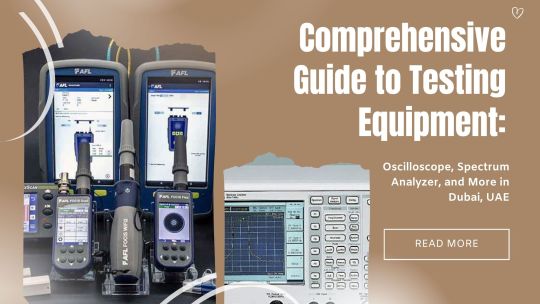
In the bustling metropolis of Dubai, UAE, where technology and innovation thrive, the demand for advanced testing equipment is paramount. From telecommunications to broadcasting, industries require precise instruments to ensure the quality and reliability of their products and services. This comprehensive guide explores some of the essential testing equipment available in Dubai, including Oscilloscopes, Spectrum Analyzers, Site Masters, Satellite Testers, DVB Testers, and TV Testers, with a focus on their applications and availability in the region.
Oscilloscope: An oscilloscope is a fundamental tool for engineers and technicians involved in electronics, telecommunications, and various other fields. It allows users to visualize and analyze the waveform of electrical signals in real-time. In Dubai, a wide range of oscilloscopes catering to different budgets and requirements are available from reputable suppliers and distributors. Whether you need a basic benchtop oscilloscope for educational purposes or a high-performance digital oscilloscope for advanced testing applications, Dubai offers numerous options from leading brands.
Spectrum Analyzer: In the realm of RF (Radio Frequency) and microwave engineering, spectrum analyzers play a crucial role in measuring the amplitude of signals across different frequencies. From troubleshooting communication systems to optimizing wireless networks, spectrum analyzers are indispensable tools for professionals in Dubai's telecommunications and broadcasting sectors. Leading suppliers in the region offer a diverse selection of spectrum analyzers, including handheld, benchtop, and portable models, suitable for various applications and environments.
Site Master: For professionals involved in the installation, maintenance, and optimization of RF infrastructure, a Site Master is an indispensable tool. Site Masters enable precise measurements of cable and antenna systems, helping to identify faults, optimize performance, and ensure compliance with industry standards. Site Master Dubai are readily available from authorized distributors, offering features such as cable and antenna analysis, distance-to-fault measurement, and frequency domain reflectometry (FDR) capabilities.
Satellite Tester Dubai: With Dubai's status as a global hub for satellite communications and broadcasting, the demand for satellite testing equipment is ever-growing. Satellite testers allow engineers and technicians to verify the performance and alignment of satellite antennas, conduct satellite signal measurements, and troubleshoot connectivity issues. In Dubai, specialized satellite testers tailored to the needs of the local market are available from trusted suppliers, offering advanced features such as DVB-S/S2 signal analysis, satellite constellation mapping, and spectrum monitoring capabilities.
DVB Tester Dubai: Digital Video Broadcasting (DVB) is the standard for digital television and radio transmission worldwide, including in Dubai and the broader UAE region. DVB testers are essential for ensuring the quality and reliability of digital TV and radio services, conducting compliance testing, and diagnosing signal issues. Dubai-based suppliers offer a range of DVB testers equipped with features such as MPEG analysis, RF signal measurement, and transport stream monitoring, enabling broadcasters and service providers to deliver a seamless viewing experience to their audiences.
TV Tester Dubai: In Dubai's dynamic broadcasting landscape, TV testers play a vital role in ensuring the quality of television signals and broadcast content. TV Tester Dubai allow operators to perform comprehensive testing and monitoring of terrestrial, cable, and satellite TV networks, identifying issues such as signal degradation, interference, and audio/video synchronization errors. Suppliers in Dubai offer a variety of TV testers equipped with features such as QAM analysis, channel scanning, and video quality assessment, empowering broadcasters and network operators to deliver superior TV experiences to viewers across the region.
Conclusion: From Oscilloscopes and Spectrum Analyzers to Satellite Testers and TV Testers, Dubai offers a wide array of testing equipment to meet the diverse needs of industries ranging from electronics and telecommunications to broadcasting and satellite communications. With leading suppliers and distributors catering to the local market, professionals in Dubai have access to cutting-edge testing solutions to ensure the quality, reliability, and compliance of their products and services in today's fast-paced technological landscape. Whether you're conducting RF measurements, analyzing digital signals, or troubleshooting broadcast networks, Dubai provides the tools you need to succeed in an ever-evolving industry.
#Oscilloscope Dubai#Spectrum Analyzer Dubai#Site Master Dubai#Satellite Tester Dubai#DVB Tester Dubai#TV Tester Dubai
0 notes
Text
How to Protect Your Pets from EMF?
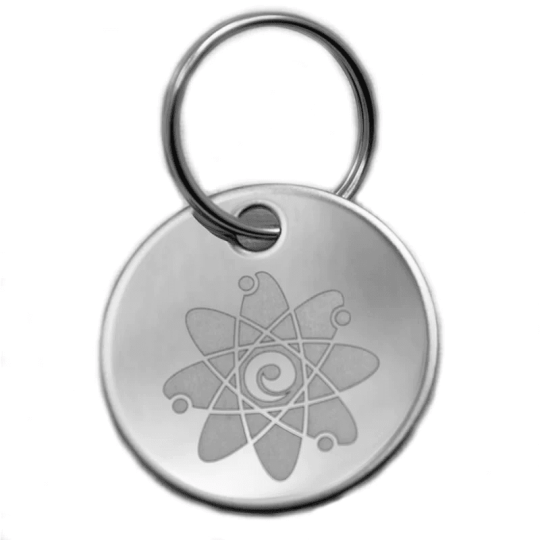
In today's digital age, our pets are exposed to a constant barrage of electromagnetic fields (EMF) from various sources such as Wi-Fi, electronic devices, and power lines. While the effects of EMF on humans have been widely discussed, the impact on our furry companions is often overlooked. As responsible pet owners, it's essential to understand how EMF can affect our pets and take proactive steps to protect them from potential harm.
you can also try this product: EMF Defense Pet Pendant
1 Understanding EMF Exposure in Pets
What is EMF? Electromagnetic fields (EMF) are invisible energy waves emitted by electronic devices, power lines, and wireless networks. They are classified into different types based on their frequency, ranging from extremely low frequency (ELF) to radiofrequency (RF) and microwave radiation.
Sources of EMF in Our Environment Our homes are filled with EMF-emitting devices like smartphones, routers, microwave ovens, and power lines. Additionally, outdoor sources such as cell towers, radio antennas, and electrical substations contribute to overall EMF exposure.
Why Pets are Vulnerable to EMF Pets, like dogs and cats, have smaller bodies and more sensitive nervous systems compared to humans. This makes them more susceptible to the effects of EMF radiation. They can experience symptoms ranging from mild discomfort to serious health issues due to prolonged exposure.
2 Recognizing Symptoms of EMF Sensitivity in Pets
Behavioral Changes Watch out for changes in your pet's behavior such as restlessness, anxiety, or unexplained aggression. EMF exposure can disrupt their natural rhythms and cause behavioral issues.
Physical Symptoms Pets may exhibit physical symptoms like fatigue, sleep disturbances, skin irritations, or digestive problems. These signs could indicate sensitivity to electromagnetic radiation.
Long-Term Health Effects Chronic exposure to EMF may contribute to more serious health problems over time, including immune system disorders, neurological issues, and even cancer in extreme cases.
you can also try this product: EMF Defense Pet Pendant

3 Creating an EMF-Free Zone at Home
Assessing EMF Levels Use EMF meters to measure radiation levels in different areas of your home. Identify high-EMF zones and take steps to minimize exposure in these areas.
Designating Safe Spaces Create EMF-free zones where your pets can retreat and rest peacefully. Consider using shielding materials like EMF-blocking paint or fabrics to create a protective barrier.
EMF Shielding Materials Invest in EMF shielding products designed specifically for pets, such as protective beds, blankets, or cages. These products can help reduce EMF exposure during sleep and relaxation.
4 Limiting Exposure Outdoors
Avoiding High-EMF Areas Steer clear of places with heavy EMF pollution, such as busy streets, industrial zones, or areas near power lines. Opt for quieter and more natural environments for outdoor activities.
Using EMF Protective Gear Equip your pets with EMF shielding accessories like protective collars or vests when venturing outdoors. These items can minimize direct exposure to EMF from external sources.
Establishing Safe Play Areas Create designated play areas in your yard or garden that are away from EMF-emitting devices. Encourage outdoor activities in EMF-free zones whenever possible.
you can also try this product: EMF Defense Pet Pendant

5 Choosing Pet-Friendly EMF-Free Products
Non-Toxic EMF Protective Gear Select EMF shielding products that are non-toxic and safe for pets. Look for materials like copper, silver, or carbon that effectively block electromagnetic radiation.
EMF-Blocking Bedding and Accessories Invest in EMF-free bedding, mats, and accessories for your pets' comfort. Ensure that these items are free from harmful chemicals and provide adequate protection.
Low-EMF Technology for Pets Choose pet-friendly technology with low electromagnetic emissions. Opt for corded devices over wireless options whenever feasible.
6 Nutritional Support for EMF Protection
Antioxidant-Rich Foods Include antioxidant-rich foods in your pets' diet to help neutralize free radicals caused by EMF exposure. Consider feeding them berries, leafy greens, and omega-3 fatty acids.
Supplements for Detoxification Consult your veterinarian about supplements that support detoxification and cellular repair. Supplements like vitamin C, magnesium, and milk thistle can aid in reducing the impact of EMF on pets' bodies.
Hydration and Electrolyte Balance Ensure your pets stay hydrated to facilitate the body's natural detoxification processes. Maintain electrolyte balance with fresh water and occasional supplementation.
you can also try this product: EMF Defense Pet Pendant

7 Behavioral Modifications for EMF Protection
Limiting Screen Time Reduce your pets' exposure to electronic screens and devices. Minimize television time and avoid leaving laptops or tablets unattended around pets.
Providing Mental Stimulation Engage your pets in mentally stimulating activities like interactive toys, puzzles, or training exercises. Mental enrichment can help alleviate stress caused by EMF sensitivity.
Monitoring Stress Levels Keep an eye on your pets' stress levels and emotional well-being. Create a calm and soothing environment at home to counteract the effects of EMF on their mental health.
8 Regular Veterinary Check-Ups and Monitoring
EMF-Related Health Assessments Schedule regular veterinary check-ups to monitor your pets' overall health, including potential symptoms related to EMF exposure. Discuss any concerns about EMF sensitivity with your veterinarian.
Consultations with EMF-Aware Vets Seek out veterinarians who are knowledgeable about EMF-related health issues. They can provide guidance and specialized care tailored to your pets' specific needs.
Early Detection and Intervention Early detection of EMF-related health issues is key to preventing long-term complications. Work closely with your vet to address any emerging symptoms and implement appropriate interventions.
By taking these proactive measures, you can significantly reduce your pets' exposure to harmful electromagnetic radiation and safeguard their well-being in our increasingly wired world. Protecting our furry companions from EMF requires diligence and awareness, but the rewards of a healthier, happier pet are well worth the effort.
you can also try this product: EMF Defense Pet Pendant
#caninept#caninetherapy#seniordogs#petspemf#caninepemf#pemf#dogsofsantabarbara#caninemassage#pets#santabarbaracalifornia#tplorecovery#dogtherapy#santabarbara#santabarbaraliving#doglife#dogpt#dogphysicaltherapy#caninerehab#animalwellness#doghealth#petphysio#ptforpets#americanriviera#caninemuscletherapy#pethealth#puppyrehab#dogpemf#dogrehab#noninvasivetherapy#dogsoflosolivios
0 notes
Text
The Brain: A Pressure Symphony of Classical and Quantum

Imagine the brain as a grand orchestra, with neurons acting as individual musicians. Quantum mechanics could be the hidden conductor, orchestrating the flow of information in a way that classical physics alone cannot explain. Just as a conductor can coax a powerful and moving performance from an orchestra, the brain, if it leverages quantum phenomena, could be capable of extraordinary feats of information processing and creativity. The more we understand the score – the laws of physics, both classical and quantum – the better equipped we are to appreciate the magnificent performance that is capable of the human brain.
Imagine the human brain not just as a complex network of neurons, but as a sophisticated quantum reservoir computer. This mind-bending hypothesis posits that the brain utilizes the bizarre laws of quantum mechanics to enhance its processing capabilities. While still theoretical, it opens doors to a universe of possibilities about how our brains might truly function.
Quantum Mechanics: The Maestro of the Dance:
Unlike the billiard-ball certainty of classical physics, quantum mechanics governs the microscopic world, introducing fascinating concepts like:
Superposition: A mind-boggling state where particles can exist in multiple states simultaneously, like a coin spinning on its edge, heads and tails at once, until a measurement forces it to choose.
Entanglement: Two particles become eerily linked, sharing a fate regardless of distance. Imagine flipping two coins, and no matter how far apart they are, they always land on the same side.
Plausible Mechanisms: Where Quantum and Classical Collide:
Could these phenomena play a role in the brain's remarkable abilities? Here are some possibilities grounded in current research:
Microtubules: Quantum Stagehands: Microtubules, tiny cellular structures, might be the key players. These hollow tubes could act as waveguides, channeling quantum information within the brain. Imagine them as microscopic fiber optic cables, but for the bizarre world of quantum phenomena.
Quantum-Assisted Signal Processing: Brain function relies on the rapid exchange of information between neurons. Quantum effects could potentially supercharge this communication, facilitating faster or more efficient signal transmission. Think of it as a quantum boost for our neural network, allowing information to flow with unprecedented speed and efficiency.
Stochastic Resonance: Embracing the Noise: Our brain might utilize a fascinating phenomenon called stochastic resonance. Imagine weak signals buried in noise. The brain could amplify these faint signals by incorporating quantum noise, enhancing its ability to make decisions in ambiguous situations.
Non-local Information Processing: Accordance (https://www.tumblr.com/ultrimio/748348095336677377/analyzing-the-intriguing-phenomenon-of?source=share) suggests that the receiver's action can influence the sender's message. Could the brain, through some unknown mechanism, utilize this principle for non-local information processing, potentially explaining phenomena like telepathy? This is highly speculative, but it highlights the need for further exploration beyond established physics.

The Brain as a Quantum Interferometer: Decoding the Universe's Symphony:
The brain's intricate structure might even act as a quantum interferometer. Just like a classical interferometer splits light waves to reveal hidden information, the brain could interact with external waves, potentially including:
Hypothetical Pressure Waves: These theorized waves could ripple through the fabric of the universe itself, carrying energy and information across vast distances. Imagine the brain acting as an antenna, picking up these subtle cosmic whispers and deciphering their secrets.
Info-Quanta: The Building Blocks of Reality?: Some physicists propose that these pressure waves are composed of fundamental units called info-quanta (similar to the luminiferous aether), the very building blocks of information itself. The brain, as a quantum interferometer, could interact with these info-quanta, potentially gaining a deeper understanding of the universe's underlying code.
Additional info on the luminiferous aether: The concept of luminiferous aether refers to a theoretical substance that was once believed to fill the universe and act as a medium for the propagation of light and other electromagnetic phenomena. Initially proposed in the 19th century, the luminiferous aether hypothesis faced significant challenges and was ultimately refuted by experiments like the Michelson-Morley experiment, leading to the development of modern physics theories like the special theory of relativity. Despite being debunked, recent research has reignited interest in the aether, with some suggesting that it could potentially unify physics by explaining phenomena like dark matter and dark energy.

Unexplored Innovations: A Glimpse into the Quantum Future:
The implications of these ideas are mind-blowing:
Enhanced Cognition: Imagine a future where the brain, leveraging quantum phenomena, possesses an unimaginable processing power, leading to breakthroughs in fields like artificial intelligence and problem-solving.
Quantum-Inspired Communication: Perhaps the brain can directly interact with these pressure waves, facilitating communication beyond the limitations of space and time. Imagine telepathy becoming a reality, not through magic, but through the power of quantum mechanics.
Quantum Healing: If the brain can manipulate quantum processes at a cellular level, it could potentially influence biological functions and even facilitate healing on a deeper level. Imagine a future where diseases are tackled by harnessing the power of the quantum brain.
Challenges and Considerations:
While these ideas are captivating, significant hurdles remain:
Limited Evidence: Currently, there's no definitive proof that quantum processes directly influence brain function. Further research is needed to validate these hypotheses.
Technical Hurdles: Measuring and manipulating quantum phenomena within a complex biological system like the brain presents immense challenges. Imagine trying to study the behavior of subatomic particles in a constantly firing neural network!
Alternative Explanations: Many aspects of brain function can be explained by classical physics. It's crucial to explore all avenues before definitively saying the quantum world plays a central role.
A Symphony Awaits:
The exploration of the brain as a quantum reservoir computer and potential interferometer pushes the boundaries of our understanding. While the concepts remain speculative, focusing on plausible mechanisms and fostering interdisciplinary collaboration between physicists, neuroscientists, and quantum biologists holds the key to unlocking the brain's true potential. The future of neuroscience might reveal a fascinating symphony where classical and quantum mechanics intertwine
#quantum reservoir computer#quantum interferometer#pressure waves (hypothetical)#info-quanta (hypothetical)#non-local fabric (hypothetical)#quantum coherence#stochastic resonance#microtubules
0 notes
Text

NASA orbiter snaps stunning views of Mars horizon
The spacecraft captured a series of panoramic images that showcases the curving Martian landscape below gauzy layers of clouds and dust. Stitched end to end, the 10 images offer not only a fresh, and stunning, view of Mars, but also one that will help scientists gain new insights into the Martian atmosphere.
The spacecraft took the images in May from an altitude of about 250 miles (400 kilometers)—the same altitude at which the space station flies above Earth.
"If there were astronauts in orbit over Mars, this is the perspective they would have," said Jonathon Hill of Arizona State University, operations lead for Odyssey's camera, called the Thermal Emission Imaging System, or THEMIS. "No Mars spacecraft has ever had this kind of view before."
How it was done
The reason why the view is so uncommon is because of the challenges involved in creating it. Engineers at NASA's Jet Propulsion Laboratory in Southern California, which manages the mission, and Lockheed Martin Space, which built Odyssey and co-leads day-to-day operations, spent three months planning the THEMIS observations. The infrared camera's sensitivity to warmth enables it to map ice, rock, sand, and dust, along with temperature changes, on the planet's surface.
It can also measure how much water ice or dust is in the atmosphere, but only in a narrow column directly below the spacecraft. That's because THEMIS is fixed in place on the orbiter; it usually points straight down.
The mission wanted a more expansive view of the atmosphere. Seeing where those layers of water-ice clouds and dust are in relation to each other—whether there's one layer or several stacked on top of each other—helps scientists improve models of Mars' atmosphere.
"I think of it as viewing a cross-section, a slice through the atmosphere," said Jeffrey Plaut, Odyssey's project scientist at JPL. "There's a lot of detail you can't see from above, which is how THEMIS normally makes these measurements.
Because THEMIS can't pivot, adjusting the angle of the camera requires adjusting the position of the whole spacecraft. In this case, the team needed to rotate the orbiter almost 90 degrees while making sure the sun would still shine on the spacecraft's solar panels but not on sensitive equipment that could overheat. The easiest orientation turned out to be one where the orbiter's antenna pointed away from Earth. That meant the team was out of communication with Odyssey for several hours until the operation was complete.
The Odyssey mission hopes to take similar images in the future, capturing the Martian atmosphere across multiple seasons.
Over the moon
To make the most of their effort, the mission also captured imagery of Mars' little moon Phobos. This marks the seventh time in 22 years that the orbiter has pointed THEMIS at the moon in order to measure temperature variations across its surface.
"We got a different angle and lighting conditions of Phobos than we're used to," Hill said. "That makes it a unique part of our Phobos dataset."
The new imagery provides insight into the composition and physical properties of the moon. Further study could help settle a debate over whether Phobos, which measures about 16 miles (25 kilometers) across, is a captured asteroid or an ancient chunk of Mars that was blasted off the surface by an impact.
NASA is participating with JAXA (Japan Aerospace Exploration Agency) in a sample return mission to Phobos and its sister moon, Deimos, called Mars Moon eXplorer, or MMX. Odyssey's Phobos imagery will be helpful to scientists working on both Odyssey as well as MMX.
IMAGE....This unusual view of the horizon of Mars was captured by NASA’s Odyssey orbiter using its THEMIS camera, in an operation that took engineers three months to plan. It’s taken from about 250 miles above the Martian surface – about the same altitude at which the International Space Station orbits Earth. Credit: NASA/JPL-Caltech/ASU
6 notes
·
View notes
Text
Navigating the Future: Trends in the Air Defense System Market
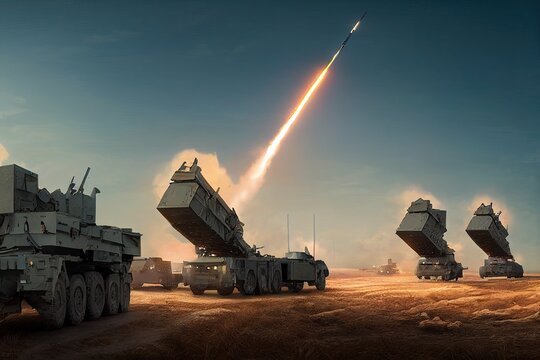
Introduction
In an era marked by geopolitical tensions, rapid technological advancements, and evolving threats, the air defense system market stands at the forefront of defense innovation. Nations worldwide are constantly striving to safeguard their skies and protect against airborne threats, propelling the demand for advanced air defense solutions. This comprehensive article explores the trends shaping the air defense system market, highlighting technological advancements, strategic shifts, and global market dynamics.
According to the study by Next Move Strategy Consulting, the global Air Defense System Market size is predicted to reach USD 62.23 billion with a CAGR of 5.2% by 2030.
Request a FREE sample, here: https://www.nextmsc.com/air-defense-system-market/request-sample
Rising Threats, Evolving Strategies
The landscape of modern warfare is undergoing a profound transformation, driven by the emergence of diverse and sophisticated airborne threats. From unmanned aerial vehicles (UAVs) to hypersonic missiles, adversaries possess an array of capabilities that challenge traditional defense mechanisms. In response, defense agencies and armed forces are investing heavily in next-generation air defense systems capable of detecting, tracking, and neutralizing these threats with precision and efficiency.
One significant trend in air defense system development is the integration of advanced sensor technologies. Radar systems equipped with phased-array antennas and active electronically scanned arrays (AESA) offer enhanced detection capabilities, enabling early warning and tracking of incoming threats. Moreover, the integration of infrared and electro-optical sensors provides additional layers of surveillance, improving situational awareness in complex operational environments.
Technological Advancements Driving Innovation
Advancements in sensor technology, data analytics, and artificial intelligence (AI) are driving innovation in air defense systems. Integrated sensor networks, powered by AI algorithms, enable real-time threat assessment and decision-making, enhancing situational awareness and response capabilities. Machine learning algorithms analyze vast amounts of sensor data to identify patterns and anomalies, enabling predictive maintenance and proactive threat mitigation.
Furthermore, the integration of directed energy weapons (DEWs) and electronic warfare (EW) systems is expanding the defensive arsenal. DEWs, such as high-energy lasers and microwave weapons, offer precise and rapid engagement of airborne threats, complementing traditional kinetic interceptors. Similarly, EW systems disrupt and deceive adversary sensors and communications, providing a layered defense against electronic attacks.
Shift Towards Network-Centric Warfare
The concept of network-centric warfare is reshaping air defense operations, emphasizing interoperability and collaboration among defense platforms and systems. Integrated air defense networks leverage data fusion and communication technologies to enable seamless coordination between ground-based radars, airborne surveillance platforms, and missile defense systems. This holistic approach enhances the effectiveness of defensive measures and minimizes response times, enabling rapid adaptation to dynamic threats.
Interoperability is further facilitated by the adoption of open standards and modular architectures, allowing for the integration of diverse systems from multiple vendors. Additionally, the use of secure communication protocols and encryption ensures the integrity and confidentiality of data shared within the network, safeguarding critical information from exploitation by adversaries.
Focus on Sustainability and Affordability
Amidst growing budget constraints and environmental concerns, there is a heightened focus on sustainable and cost-effective air defense solutions. Defense contractors and technology providers are leveraging innovations in materials science and manufacturing processes to develop lightweight and energy-efficient systems that minimize operational costs and environmental impact. Advanced composites and additive manufacturing techniques enable the production of complex components with reduced weight and increased durability, enhancing system performance and longevity.
Furthermore, the adoption of modular and scalable architectures enables flexibility and adaptability, allowing defense agencies to tailor their air defense capabilities to evolving threats and budgetary constraints. Modular systems facilitate incremental upgrades and technology refresh cycles, ensuring that air defense platforms remain operationally relevant throughout their lifecycle. Additionally, the use of commercial off-the-shelf (COTS) components and open architectures lowers acquisition costs and reduces reliance on proprietary systems, promoting interoperability and vendor diversity.
Inquire before buying, here: https://www.nextmsc.com/air-defense-system-market/inquire-before-buying
Global Market Dynamics
The global air defense system market is characterized by intense competition and a diverse supplier base, comprising both established defense contractors and emerging technology startups. While developed nations continue to dominate defense spending, emerging economies are increasingly investing in indigenous air defense capabilities to enhance their national security posture. Regional dynamics, geopolitical tensions, and strategic alliances also play a significant role in shaping market trends and demand patterns.
In Asia-Pacific, for example, rising geopolitical tensions and territorial disputes have fueled demand for advanced air defense systems. Countries such as China, India, and South Korea are investing heavily in indigenous research and development initiatives to strengthen their air defense capabilities and reduce reliance on foreign suppliers. Similarly, in the Middle East, ongoing conflicts and security threats have spurred investments in missile defense systems and integrated air defense networks.
Technological Collaboration and Joint Ventures
In the increasingly interconnected global defense industry, technological collaboration and joint ventures play a crucial role in driving innovation and expanding market reach. Defense contractors from different countries often collaborate on joint development programs to leverage each other's expertise and resources. These partnerships enable the sharing of technological know-how and the pooling of resources, resulting in the development of cutting-edge air defense systems that meet the evolving needs of customers worldwide.
Regulatory Environment and Export Controls
The air defense system market is subject to stringent regulatory requirements and export controls imposed by governments to safeguard sensitive technologies and prevent proliferation risks. Export controls dictate the transfer of defense-related technologies and equipment between countries, requiring exporters to obtain licenses and comply with strict regulations. Changes in export control policies and international agreements can significantly impact market dynamics, influencing the flow of defense exports and collaborations between countries.
Emerging Threats and Adaptive Strategies
As adversaries continue to innovate and adapt their tactics, defense agencies and armed forces must stay ahead of emerging threats by developing adaptive strategies and capabilities. The proliferation of unmanned aerial systems (UAS) and low-cost drones poses a particularly challenging threat, requiring agile and scalable air defense solutions. In response, defense contractors are investing in counter-UAS technologies, such as kinetic interceptors, electronic warfare systems, and drone detection platforms, to mitigate the risks posed by these emerging threats.
Commercialization and Dual-Use Applications
The commercialization of defense technologies and the emergence of dual-use applications are reshaping the air defense system market landscape. Many defense technologies, originally developed for military purposes, are finding civilian applications in sectors such as aerospace, transportation, and telecommunications. This dual-use approach enables defense contractors to diversify their revenue streams and leverage economies of scale, driving down costs and accelerating technological innovation. Additionally, commercial off-the-shelf (COTS) components and software solutions are increasingly integrated into air defense systems, reducing development time and costs while enhancing interoperability and performance.
Conclusion
As the global security landscape continues to evolve, the importance of air defense systems in safeguarding national sovereignty and protecting critical assets has never been greater. By embracing technological innovation, fostering collaboration, and prioritizing sustainability, the air defense industry is poised to navigate the challenges of the future and ensure the safety and security of nations around the world. With ongoing advancements in sensor technology, AI, and network-centric warfare, air defense systems will continue to evolve to meet the dynamic threat environment, providing reliable protection against airborne threats for years to come.
0 notes